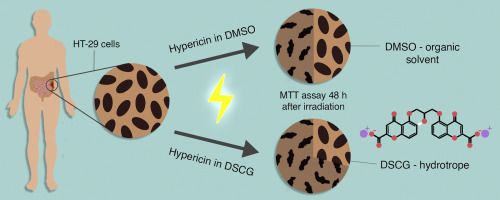Journal of Photochemistry and Photobiology B: Biology ( IF 3.9 ) Pub Date : 2020-03-14 , DOI: 10.1016/j.jphotobiol.2020.111855 Mária Suváková 1 , Martin Majerník 2 , Rastislav Jendželovský 2 , Andrej Hovan 3 , Gregor Bánó 3 , Peter Fedoročko 2 , Marián Antalík 4

|
Hypericin (HY) is a naphthodianthrone that naturally occurs in Hypericum perforatum L. It is a promising photosensitiser used in photodynamic therapy for and diagnosis of oncological diseases. However, its hydrophobic character is an obstacle that has prevented its efficient use. The commonly used solvent, dimethyl sulfoxide (DMSO), is a controversial constituent of HY formulations and its use has been rejected by many researchers studying HY both in vitro and in vivo. In this study, we propose the utilisation of hydrotropy to solubilise HY in an aqueous environment. Cromolyn (DSCG) is a non-toxic, well-tolerated, antiallergic drug that has been employed in clinical practice since 1970, and in aqueous solution it acts as a hydrotrope. At a molecular ratio of 1:12,000 HY to DSCG, the compound is able to solubilise HY in aqueous environment. In an HT-29 cell suspension, DSCG (1.8 mmol L−1) considerably enhances the interaction between HY (150 nmol L−1) and HT-29 cells, which leads to an HY fluorescence emission increase with a half-time approximately 2 min compared to 29 min for samples that lack DSCG. Studies using HT-29 adenocarcinoma cells showed that DSCG at a given concentration significantly improved accumulation of HY within cells compared to DMSO (p ˂ 0.05) despite the relative resistance of the HT-29 cell line to HY-PDT. Though no significant difference between total reactive oxygen species production was observed for photoactivated HY dissolved in DMSO and DSCG, significant singlet oxygen generation by photoactivated HY dissolved in a DSCG-containing water solution at the studied molecular ratio was confirmed. We also clarified that DSCG does not act as a scavenger of ABTS and galvinoxyl free radicals. The results from an MTT assay showed that DSCG also significantly enhanced the cytotoxicity of photoactivated HY compared to DMSO (p ˂ 0.05). This study has demonstrated the ability of DSCG to act as a solvent of HY and enhance the effectiveness of HY-PDT compared to the commonly used organic solvent, DMSO.
中文翻译:

色甘酸二钠作为一种新型有效水溶助剂溶剂用于光动力疗法中金丝桃素的体外研究
金丝桃素 (HY) 是一种天然存在于贯叶金丝桃中的萘二蒽酮。它是一种很有前途的光敏剂,用于肿瘤疾病的光动力治疗和诊断。然而,其疏水特性是阻碍其有效利用的障碍。常用的溶剂二甲亚砜 (DMSO) 是 HY 配方中颇具争议的成分,许多研究 HY体外和体内的研究人员都拒绝使用它。在这项研究中,我们建议利用水溶助剂在水环境中溶解 HY。色甘酸 (DSCG) 是一种无毒、耐受性良好的抗过敏药物,自 1970 年以来一直用于临床实践,在水溶液中充当水溶助长剂。当 HY 与 DSCG 的分子比为 1:12,000 时,该化合物能够在水性环境中溶解 HY。在 HT-29 细胞悬浮液中,DSCG (1.8 mmol L -1 ) 显着增强 HY (150 nmol L -1 ) 和 HT-29 细胞之间的相互作用,导致 HY 荧光发射增加,半衰期约为 2分钟,而缺乏 DSCG 的样品为 29 分钟。使用 HT-29 腺癌细胞的研究表明,与 DMSO 相比,给定浓度的 DSCG 显着改善了细胞内 HY 的积累 (p ˂ 0.05),尽管 HT-29 细胞系对 HY-PDT 具有相对抵抗性。虽然溶解在 DMSO 和 DSCG 中的光活化 HY 的总活性氧产生量没有观察到显着差异,但证实了以所研究的分子比溶解在含有 DSCG 的水溶液中的光活化 HY 产生显着的单线态氧。 我们还澄清 DSCG 不能充当 ABTS 和加尔万氧基自由基的清除剂。 MTT 测定结果表明,与 DMSO 相比,DSCG 还显着增强了光激活 HY 的细胞毒性(p ˂ 0.05)。这项研究证明了与常用的有机溶剂 DMSO 相比,DSCG 能够充当 HY 的溶剂并增强 HY-PDT 的有效性。











































 京公网安备 11010802027423号
京公网安备 11010802027423号